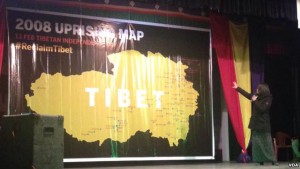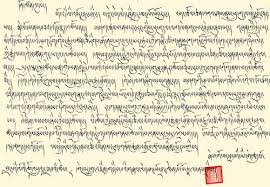
Concert at the Tibetan Institute of Performing Arts in McLeod Ganj
Photo: SFT
Students for a free Tibet groups around the world celebrated Tibetan Independence day on February 13, three years since the 100-year anniversary of Tibet’s Declaration of Independence. This year’s theme was “Reclaim Tibet”. Pema Yoko, Acting Executive Director of Students for a Free Tibet, said, “By publicly commemorating our proud history as an independent nation… we are reclaiming our past for future generations”. Sell-out concerts were held in McLeod Ganj and Delhi, attended by Tibetans, Indians and many supporters.
Since the 100-year commemoration in 2013, Tibetans, supporters and activists have continued to organise and participate in events on this day, from concerts and flag-raising ceremonies to protest actions at embassies.

His Holiness the 13th Dalai Lama
photo: Wikipedia
The original Declaration was a written statement by Thubten Gyasto, the 13th Dalai Lama, on February 13, 1913, declaring Tibetan independence from the Qing (Manchu) dynasty. The Chinese Xinhai Revolution caused the collapse of China’s last imperial dynasty and with the expulsion of the last remaining Qing troops from Tibet, the 13th Dalai Lama returned to the Tibetan capital of Lhasa, ending a three-year exile in British India. There followed four decades of Tibetan independence, with Tibet running its own administration, currency, military and legal, taxation and postal systems which only ceased when China invaded Tibet in 1951 and brought it under the control of the communist People’s Republic of China.
 The 1913 Declaration looked forward to a return to “happiness and peace” under Tibetan self-rule, calling on Tibetans to preserve Buddhist institutions, separate the administration of monasteries from commerce, end corruption and exploitation by landowners and local, civil and military officials, and to work collectively to tackle and avoid conflict with other countries.
The 1913 Declaration looked forward to a return to “happiness and peace” under Tibetan self-rule, calling on Tibetans to preserve Buddhist institutions, separate the administration of monasteries from commerce, end corruption and exploitation by landowners and local, civil and military officials, and to work collectively to tackle and avoid conflict with other countries.
 Past celebrations of Tibetan Independence Day in European capitals have involved public readings of the Declaration and awareness-raising exhibitions and demonstrations. Centenniel celebrations in India in 2013 included a freedom marathon organised by Students for a Free Tibet-Delhi; an exhibition of documents, artefacts and photographs corroborating Tibet’s prior status as an independent nation in McCleod Ganj and a two-day conference, the Fourth Preliminary International Rangzen Conference, held by the Tibetan Youth Congress (TYC).
Past celebrations of Tibetan Independence Day in European capitals have involved public readings of the Declaration and awareness-raising exhibitions and demonstrations. Centenniel celebrations in India in 2013 included a freedom marathon organised by Students for a Free Tibet-Delhi; an exhibition of documents, artefacts and photographs corroborating Tibet’s prior status as an independent nation in McCleod Ganj and a two-day conference, the Fourth Preliminary International Rangzen Conference, held by the Tibetan Youth Congress (TYC).
China has continued to deny the period of Tibetan independence from 1913, with China’s official Xinhua news agency labelling it a “myth” and stating the declaration is a “fabrication”. Thus the 1913 Declaration remains, according to SFT executive director Tenzin Dorjee, “a reminder of Tibet’s historical past as an independent nation, which China tries to negate and distort.”




 Print
Print Email
Email